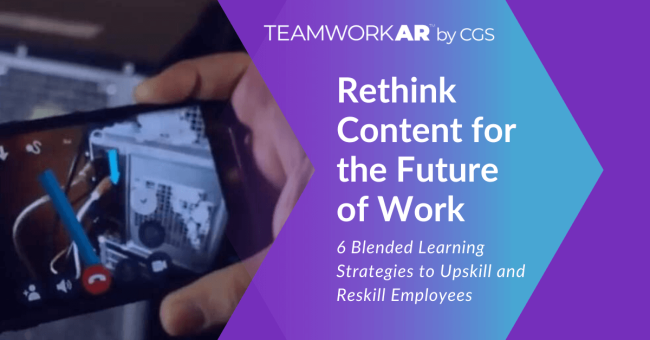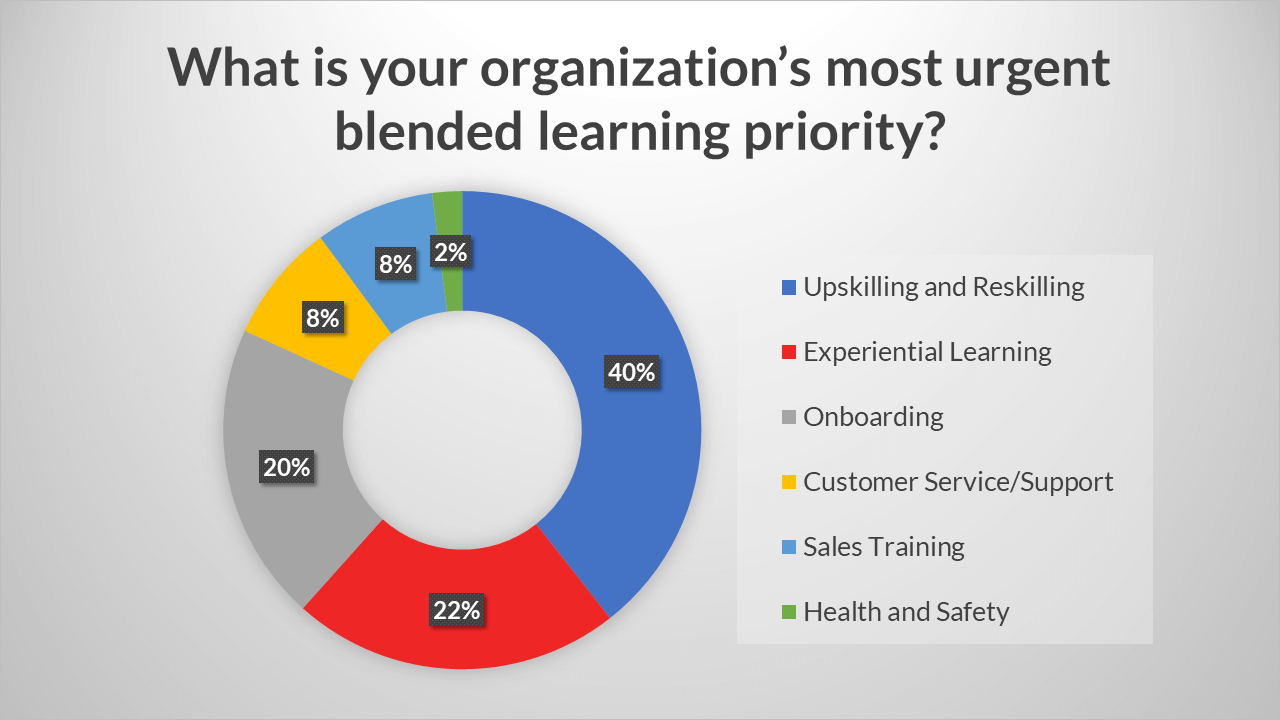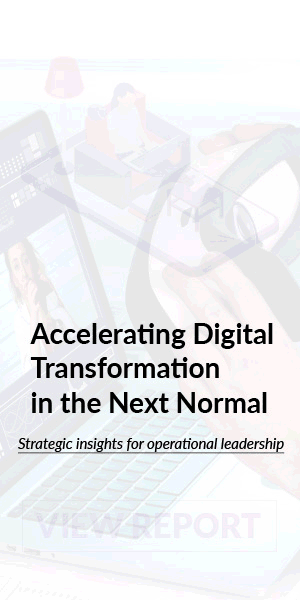3 Blended Learning Strategies Using Mixed Reality

Rethink Your Content for the Future of Work
This blog is part 1 of a two-part series. Watch for more blended learning examples in Part 2.
The past year-plus has forced companies to rethink how they do business from top to bottom. In many cases, just conducting ‘business as usual’ required a lot of pivoting behaviors and priorities. And it could be said that learning professionals were some of the most important people in this process. They adapted to a new way of working, while also supporting staff who had to make sudden changes, sometimes in a week or less, in how they collaborate, interact and learn. While the pandemic is thankfully improving for many countries, a lot of the innovations and technologies we embraced to get us through will become an integral part of the next normal.
In a recent product demo webinar sponsored by Training Industry, Enterprise Learning President Doug Stephen offered insights and real-world examples of blended learning in action that have helped, and will continue to help, companies thrive. Over the past year, the companies that used blended learning saw greater agility and success in L&D, which in turn improves many other aspects of a business’s performance.
Blended learning is basically training across multiple modalities, such as eLearning, mobile learning, instructor-led and experiential instruction. When implemented successfully, learning via blended modes can increase employee engagement, improve flexibility, encourage collaboration between employees and boost productivity and sales.
At the start of the webinar, participants answered a quick question about their most urgent priority for blended learning. The results surprised Stephen and differed slightly from the results we saw in our survey of L&D leaders earlier in 2021.

While health and safety easily took the priority for L&D leaders then, this group was more focused on reskilling and upskilling, experiential learning and onboarding, all of which aid the climate in which we find ourselves.
This is the first of two blogs based on these priorities. Below you’ll find examples of blended learning using Augmented Reality (AR) or Extended Reality (XR) shared during the webinar that offer insight and direction to move L&D forward in the next normal.
1 Experiential Learning
What if you could assemble or repair a product you had never seen before? What if you could use nontechnical staff to solve technical issues? What if you could train employees with line-of-sight technology before they enter the field? Experiential learning with augmented reality or extended reality technology offers this and much more. It opens so many possibilities with learning and development. Using AR-assisted support, it’s estimated that 48 percent of issues can be resolved without a field service visit.
Some of the many benefits of learning in the flow of work include:
- Just-in-time training
- Object recognition and familiarization
- Hands-on learning for better retention
- Increased safety and efficiency
- Reduced downtime
Imagine your shop’s fancy beverage machine experiences an error. Whatever the severity of the repair, previously, a specially trained technician would have to be scheduled for in-person service. It could take days to bring them in to fix it. That means lost productivity and lost sales.
Now imagine that perhaps the error could be resolved by clicking a few buttons or tweaking a couple of settings. Instead of waiting for a technician, you could use a tablet or smartphone to videocall the manufacturer for support. That technician can see what you see, open help files, show you videos, overlay 3D information and even draw on the screen to identify key steps or parts. The machine could be back in operation in minutes or hours, instead of days or weeks.
Another example, this time for financial institutions, is around managing forms. Imagine a new staff member needs to learn how to complete a complex form. The printed form is laid out on the desk in front of them. Using AR or XR, they can view the form through their device’s camera as it points out the fields to complete on the form. Additionally, it could also link to pop-up information or videos on “why” you are completing this information.
Learning with experiential technology goes much deeper and can be retained easier. The human brain processes visual information 60,000 x faster than text. XR and AR create new visual cues to train the brain.
Bear in mind, the learning behind experiential technology is still there. You are still writing and building step-by-step instructions using best practices. But by wrapping new technology around solid instructional basics, you can empower customers, boost effectiveness and create better experiences and satisfaction. You can also reduce support costs and improve productivity at both yours and your customers’ operations.
2 Reshaping the Sales Process
In today’s marketplace, 96 percent of B2B sales teams have fully or partially shifted to remote sales. And 79 percent of B2B teams say they will likely sustain this model for 12 months or more beyond the pandemic. Experiential tech like AR is tailor-made for remote sales and are reshaping companies’ sales strategy and process.
With the right technology, sales teams can expand the traditional presentation and include interactive content and information, including details and specifications. Customers who walk into your store can use their device’s camera, and key details about your products will display. Once clicked, it will pop up with more information. Stephen offered one example of a technology shop in which customers can hover their device’s camera over a new smartphone and view information about its chip set, durability, product colors available and more. The possibilities are almost limitless.
Using interactive overlays, companies can increase sales and improve customer adoption for technology and products.
3 Safe, Healthy and Productive
The pandemic reinforced and redefined the need for health and safety in the workplace. Being able to work in a safe, secure manner will continue to be important to businesses in the future. Let’s look at how two companies kept employees safe while staying productive.
Digital Twin – A Case Study
Toshiba Global Commerce Solutions came to us with an issue. As the pandemic raged, they had 315 technicians nationwide who worked with big-box stores to keep point of sale (POS) machines in operation. This required a lot of travel, not only to repair the actual machines but also to receive initial training on how to repair them.
Before COVID, staff would fly to the offices in Atlanta to be trained on how to repair these large machines. Last year that was no longer a viable option. So, the company partnered with us to produce an experiential technology that would allow them to train staff while staying safe, using virtual models of the equipment.
We built a cost-effective solution that avoided travel and allowed staff to work on complex equipment from home. It’s simple but powerful. Using Teamwork AR™, their employees can learn and practice on equipment that is not there. They drop what is called a “digital twin” —a 3D model of the actual machines used in stores nationwide—into their living room. Using this digital content, they can learn the various parts and procedures of how to service the POS machine. Employees learned about the devices, the company saved on travel and the whole process kept employees safe and productive. Now they are ready for scale.
On the Frontline
Not everyone could work remotely last year, however. Frontline workers still needed to be out there, providing vital services. A large dining services corporation came to us for a solution to help train employees on new safety, cleaning and operational procedures.
Working closely together, we created interactive new training modules that showed employees new measures to keep safe, clean and productive in this new environment. Interactive elements allowed employees to click on the breakroom, kitchen and other areas to see what new measures were in place. Stephen said, where possible, “we peppered in video of real employees” to reinforce the training in a realistic and personal manner. Stock graphics were used to augment what couldn’t be produced with actual employees.
One powerful component included in the training is checklists. Using checklists can be a gamechanger, Stephen said. A visual reminder for all the steps to take helps everyone be more productive and reduces accidents and errors.
Stephen referenced The Checklist Manifesto: How to Get Things Right, which examines using checklists in personal and professional life. Its writer, Atul Gawande, a surgeon, focused on the business and medical professions. When checklists were adopted by doctors working in the WHO, they saw a reduction in deaths. The point: Even very smart people need to remember simple steps. It’s why CGS Enterprise Learning highly recommends using takeaway checklists in all their training.
The Perfect Blend
Each company may need a different blend of learning modalities to ensure their L&D program’s success. But there’s no doubt some of these shifts and technological advancements from the pandemic will remain part of the program even down the road. And as employees come from different backgrounds, have different skillsets and learn in different ways, a blended model is still the best approach.
Tried-and-true learning methods like instructor-led training will continue to be important, especially in certain industries, but blending them with other modes like XR/AR, video vignettes and social training will ensure your training and learning is accessible, understandable, effective and powerful.
Contact our learning professionals to learn how we can engage and empower your employees for success.

